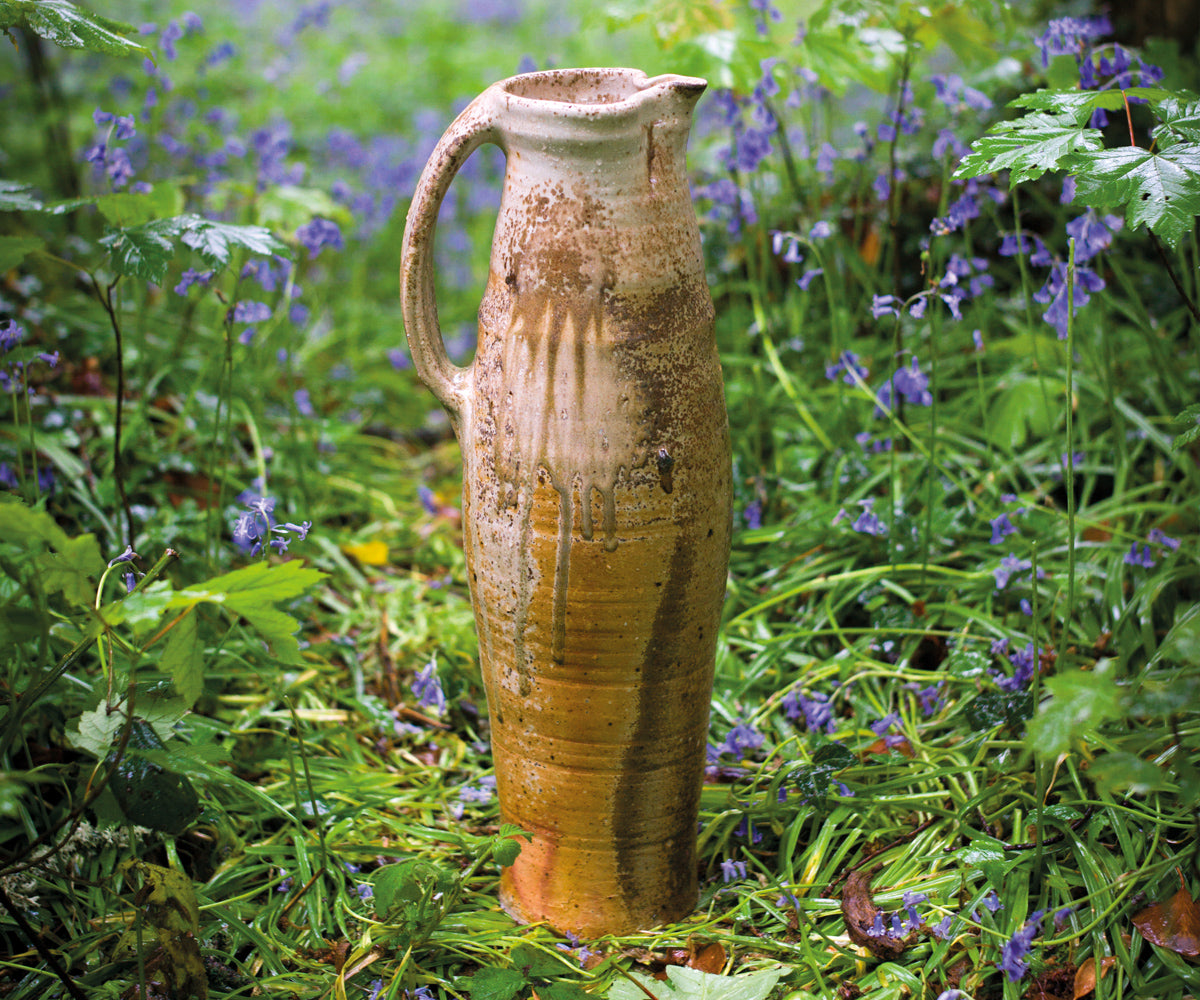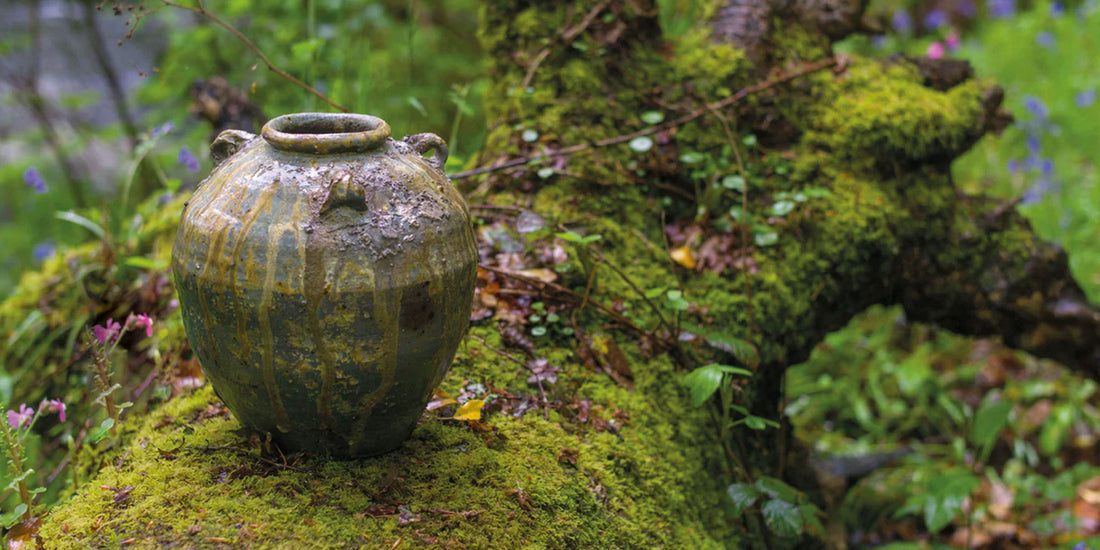On July 1st, British potter and wood-firer extraordinaire Nic Collins opened his third major ceramics exhibition at Goldmark. We don't feel it is any exaggeration to say that the work included in this mammoth show - over three-hundred pots' worth - is the very best Collins has ever produced, a staggering testament to his ongoing relationship with the ferocious fires of his anagama kiln.

Published here is a compiled interview from the few special times we have spent with Nic in his Devon studio talking about pots and his inspirations. Read on for an insight into the risks and rewards that surround this way of working...

GG: Perhaps you could describe in a nutshell what your work is about.
Collins: I find perfection very boring; I’m looking for something slightly different. That’s why, when you look at my pots, they’re not perfectly round, they’ll have scars from the fire, but that’s everything I’m looking for in wood firing. I remember when I was training at college there was a girl I fell in love with, not because she was conventionally beautiful - she had this great scar down her face – but because she was different. She was amazing. And if my pots can carry that kind of power, then I’m happy with that.

GG: Where did your life as a potter begin?
Collins: I grew up just outside Stratford-upon-Avon and ended up at Derby College of Higher Education, where I was pretty much given free rein. I had a big pile of firebricks and could sit up all night building and firing kilns, and gradually it became an obsession. Clay was everything.
When I came out of Derby, I really didn’t know what I was going to do. I got a little Mini pickup and went to work in a pottery in the South of Italy, coming back up through Germany where I worked for a wood firer. That’s where I first saw the old kick wheel that I use today, which I built from a photograph. When I came back to England, I had a thousand pounds in my pocket, my pickup, my wheel, and a thousand bricks from a company in Sheffield which I’d swapped for a teapot.

My first firing, we hadn’t got enough wood and had to burn all my ware boards just to reach cone 9 (1280˚C). They’re probably the worst pots I’ve ever made and I’m sure they’ll turn up and haunt me someday, but they were our saviour, because we had a kiln load of work and managed to sell it.

GG: Having spent time in Europe, a number of your assistants have also come from abroad. Do you find similarities in the way these potters work with what you’re doing here in Devon?
Collins: We get a lot of German potters here, but their way of making pots is so different to what I do. They seem more about the head than the heart. They would take a lump of clay, and are taught to throw it as thinly as possible, as wide as possible, to squeeze as much out of that lump as you can and fast, which I feel may be missing the point. With that kind of throwing, the pots become very mean and very sharp, not something you want to pick up.

I went through that process of throwing as thinly as I could myself, and as evenly, and as many as possible off the wheel in a day, and there comes a time when you have to undo that. It’s not just about being able to throw a pot well: it’s about bringing something extra, something special.
A good pot might not necessarily jump out at you at eye level, but there’s something that makes you want to pick it up, and I truly believe that those pots have a little of the potter’s soul in them. There’s something a little extra that’s injected to make a person want to touch and feel and explore a pot. I think that’s what I mean by from the heart and not the head.

GG: Have you been inspired by any of the foreign potters you’ve worked with?
Collins: One Japanese potter who was extremely influential for me was a guy called Shiro Tsujimura. He came to Devon and stayed with some friends of mine, working for an exhibition for the Galerie Besson in London. Now, this guy was not your usual Japanese potter. He was the son of a dairy farmer who went on to become a Buddhist monk and then got into pots looking at antique Japanese ceramics. But he approached it in the manner that a child would: he’d seen a pot, he’d made up in his mind how it was made, and he’d just do it. This guy broke all the rules and made beautiful pots. They had that soul in them, that feeling, that primeval, deep down something that grabs you.

He was firing this little kiln with oil and throwing wood ash on the pots, and just as he was finishing the firing I went to see him. He climbed up the kiln and threw this big wodge of clay on the hole where the oil burner was. There were holes everywhere. It was like a cathedral, with all the light shining out, and everything that I’d been taught told me that those pots would be dunted, they’d all be cruds, there’d be nothing left. I went along the next day when he opened this kiln and pulled out his first pot – man my heart! – it was a stunner, a real stunner. That was a valuable lesson for me. It taught me that rules are there to break; sometimes it works, sometimes it doesn’t. But when you take those risks, you will get some reward.

GG: You mention risk; there are few more risky ways of making pots than the kind of anagama wood firing that you do. Do you enjoy this process, and all the perils it brings?
Collins: I think the firing is one of the most important things for me, as a potter. There’s a kind of grey area between studio ceramics and fine art – a very positive and strong area - and I think it’s only really wood firing that can reach into that space. It’s very much like painting, and when I pack the kiln that’s exactly what I’m doing: I’m imagining where the fire is going to hit, what clay and glazes and therefore what colour palette I’m using, where’s the ash going to run, how the flame is going to hit this pot and then weave around and hit another.

My pots are made to try and capture what will happen in my kiln. I do a four-day firing, and I do a lot with the fire; it’s not just about getting it up to temperature. I like to stack pots on their sides, surround pots with embers when I’m stoking, and I play around with the path of the flame. Sometimes pots get knocked over, and although I try to right them it’s very difficult when the kiln is at 1300˚C. Pots at the front are often stuck together, and I like to stack pots on top of pots which can work really well but is a big gamble. Some firings are almost perfect, others almost everything is damaged. To get one nice pot, you may have to sacrifice three or four. Usually there’s one obvious piece to smash and we can get them apart, but when you have two beautiful pots stuck together it becomes a bit of a dilemma. Doesn’t that make the survivor twice as special though?

A lot of people say these results are accidental, which makes me a little bit angry because they’re not. It’s all very controlled. It’s out-of-control control, if that makes any sense: you have an idea and you push for that, but always there comes something unexpected. I think that’s probably the drive for a wood firer: that most of the time it’s not what you expect.

GG: There seems to be an element of masochism with wood firing, that idea of the artist who suffers for their work.
Collins: This kiln has had me in tears. I don’t think a woman has ever done that to me, but that’s probably a lie! It’s a relationship. It’s a battle all the time, but you have to work on good relationships. I’m getting there; we’re getting there together, me and this clay stuff, and fire. It’s about understanding, working with, being at ease with, and accepting what you think might be faults and appreciating those differences. With wood firing there’s always going to be that question, where does the personality come from: the maker, or the fire? Well it’s got to be both, hasn’t it? There’s this relationship, this battle, this big fight: it takes and it gives.

GG: And who’s winning the fight?
Collins: I would say, at the moment, the fire is winning. I like my input; but the fire has the big say.










